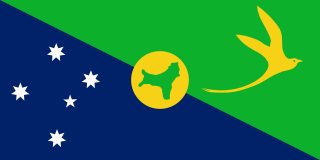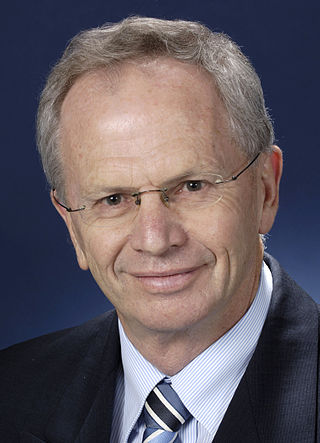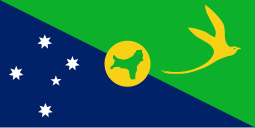
The Territory of Christmas Island is an Australian external territory in the Indian Ocean comprising the island of the same name. It is located approximately 350 kilometres south of Java and Sumatra and about 1,550 km (840 nmi) north-west of the closest point on the Australian mainland. It has an area of 135 square kilometres (52 sq mi). The territory derives its name from its discovery on Christmas Day 1643 by Captain William Mynors.

The Cocos (Keeling) Islands, officially the Territory of Cocos (Keeling) Islands, are an Australian external territory in the Indian Ocean, comprising a small archipelago approximately midway between Australia and Sri Lanka and relatively close to the Indonesian island of Sumatra. The territory's dual name reflects that the islands have historically been known as either the Cocos Islands or the Keeling Islands.

Norfolk Island is an external territory of Australia located in the Pacific Ocean between New Zealand and New Caledonia, 1,412 kilometres (877 mi) directly east of Australia's Evans Head and about 900 kilometres (560 mi) from Lord Howe Island. Together with the neighbouring Phillip Island and Nepean Island, the three islands collectively form the Territory of Norfolk Island. At the 2021 census, it had 2,188 inhabitants living on a total area of about 35 km2 (14 sq mi). Its capital is Kingston.

Phillip Island is an Australian island about 125 km (78 mi) south-southeast of Melbourne, Victoria. The island is named after Governor Arthur Phillip, the first Governor of New South Wales, by explorer and seaman George Bass, who sailed in a whaleboat, arriving from Sydney on 5 January 1798.

The coat of arms of Australia, officially the Commonwealth Coat of Arms, is a formal symbol of the Commonwealth of Australia. It depicts a shield, containing symbols of Australia's six states, and is held up by native Australian animals, the kangaroo and the emu. The seven-pointed Commonwealth Star surmounting the crest also represents the states and territories, while golden wattle, the national floral emblem, appears below the shield.

Jonathan Donald Stanhope is a former Australian politician who was Labor Chief Minister of the Australian Capital Territory from 2001 to 2011. Stanhope represented the Ginninderra electorate in the ACT Legislative Assembly from 1998 until 2011. He is the only ACT Chief Minister to have governed with a majority in the ACT Assembly. From 2012 to 2014 Stanhope was Administrator of the Australian Indian Ocean Territories, which consists of Christmas Island and Cocos (Keeling) Islands.
The title Administrator of the government (Administrator) has several uses in Australia.
The parliaments of the Australian states and territories are legislative bodies within the federal framework of the Commonwealth of Australia.

.cx is the country code top-level domain for Christmas Island. It is administered by the Christmas Island Internet Administration, through the Christmas Island Domain Administration Limited. The Christmas Island Internet Administration is a community-owned non-profit company which also provides Internet service to the island's residents. .cx is a member of the Council of Country Code Administrators, a group of country-code domains making use of common registry and/or dispute resolution services.

The Wheatbelt is one of nine regions of Western Australia defined as administrative areas for the state's regional development, and a vernacular term for the area converted to agriculture during colonisation. It partially surrounds the Perth metropolitan area, extending north from Perth to the Mid West region, and east to the Goldfields–Esperance region. It is bordered to the south by the South West and Great Southern regions, and to the west by the Indian Ocean, the Perth metropolitan area, and the Peel region. Altogether, it has an area of 154,862 square kilometres (59,793 sq mi).

Evan John Williams is a retired Australian diplomat and public servant who served as the Administrator of the Australian Indian Ocean Territories from 1 November 2003 until 31 October 2005.

The Australian Indian Ocean Territories is the name since 1995 of an administrative unit under the Australian Department of Infrastructure, Transport, Regional Development, Communications and the Arts, consisting of two island groups in the Indian Ocean under Australian sovereignty:

The Shire of Christmas Island is a local government area encompassing the Australian external territory of Christmas Island. Under the Christmas Island Act, Western Australian laws apply to the island, including the Local Government Act 1995.

The Shire of Cocos (Keeling) Islands is a local government area which manages local affairs on the Australian external territory of Cocos (Keeling) Islands. The island is grouped with Western Australia but is administered by the Department of Infrastructure, Regional Development and Cities and an Administrator.
The Christmas Island Resort, often called the Christmas Island Casino, is a holiday resort on Christmas Island, an Australian territory in the north-eastern Indian Ocean about 380 kilometres (240 mi) south of Java and 1,600 kilometres (990 mi) north-west of the Australian mainland. The resort, including an integrated casino, opened in late 1993. The casino was generally profitable, with gross profits from casino operations peaking at $153.7 million in 1994-95. Overall, however, the casino and resort struggled financially and, after being badly affected by the Asian Financial Crisis, it was closed on 23 April 1998.
The following lists events that happened during 2015 in Australia.
Alexander Donald Taylor AM was an Australian politician who was a Labor Party member of the Western Australian Legislative Assembly from 1968 to 1984, representing the electoral district of Cockburn. He served as a minister in the government of John Tonkin, including as deputy premier from 1973 to 1974. Taylor later served as Administrator of Christmas Island from 1986 to 1990.












